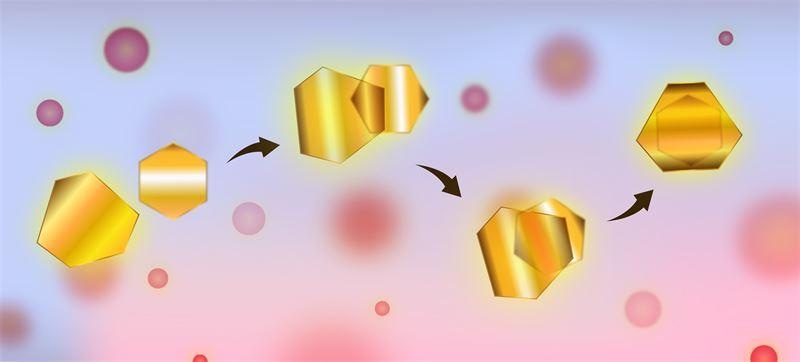For studying materials at the nano-level, scientists repeatedly need to build a complex structure in which to contain the materials – a laborious and difficult process. However, imagine if there was a method where the structure could just build itself?
 Attracted gold flakes. Researchers at the Chalmers University of Technology have discovered that two gold nanoflakes can connect to each other, solely through naturally occurring forces, to form a versatile nanoscopic structure useful for exploring new physical phenomena. (Image Credit: Chalmers University of Technology | Yen Strandqvist).
Attracted gold flakes. Researchers at the Chalmers University of Technology have discovered that two gold nanoflakes can connect to each other, solely through naturally occurring forces, to form a versatile nanoscopic structure useful for exploring new physical phenomena. (Image Credit: Chalmers University of Technology | Yen Strandqvist).
That is precisely what scientists from the Chalmers University of Technology, Sweden, now describe in an article published in the journal Nature. Their study paves the way for new research openings.
Exploring nanomaterials can facilitate the study of entirely new properties and interactions. To be able to realize this, various types of ‘resonators’ are mostly required – meaning, in this context, an object within which light bounces around, similar to the way sound bounces inside a guitar’s body.
At present, scientists working at the Department of Physics at the Chalmers University of Technology, have learned how a previously known version of a resonator, composed of two parallel mirrors, can be engineered and regulated in a much simpler manner than earlier believed.
Creating a high quality, stable resonator, such as we have done, is usually complicated and requires many hours in the laboratory. But here, we saw it happen of its own accord, reacting to naturally occurring forces, and requiring no external energy input. You could practically make our resonator in your own kitchen – it is created at room temperature, with ordinary water, and a little salt.
Timur Shegai, Research Leader and Associate Professor, Department of Physics, Chalmers University
Shegai was himself astonished by the nature of the discovery in the laboratory.
A Self-Assembling and Growing System
Shegai and his colleagues noticed that when two tiny gold flakes – 5,000 nm in diameter and only 30 nm thick – encountered each other in a salty aqueous solution, an interaction develops that causes them to develop a pair.
Both the two gold flakes are positively charged as the aqueous solution covers them with double layers of ions. This results in a repelling electrostatic force, but, because of the instantaneous impact of something known as the “Casimir effect”, an attracting force is also formed, and a stable balance develops, causing a distance between the flakes of about 150 nm.
The two nanoflakes arrange themselves facing one another, with a cavity developed between them, and they stay stable in this orientation for weeks of observations. The cavity then works as an optical resonator, a device that offers a number of opportunities to investigate different physical phenomena.
After the gold flakes have developed a pair, they remain in place, and the scientists also witnessed that, if not actively divided, more and more bits of gold search for each other and develop a larger grouping. This means that the structure, only through naturally arising forces, can grow and form more stimulating opportunities for scientists.
The structure can be further exploited by incorporating more salt into the aqueous solution, altering the temperature or by illuminating it with lasers, which can result in some intriguing observations.
What is so interesting in this case is that there are colours which appear inside the resonator. What we’re seeing is basically self-assembled colour. This combines a lot of interesting and fundamental physics, but at the same time it’s very easy to make. Sometimes physics can be so surprising and so beautiful.
Timur Shegai, Research Leader and Associate Professor, Department of Physics, Chalmers University
Studying the Meeting Point Between Light and Matter
The structure can then be employed as a chamber for examining materials and their behavior. By positioning a two-dimensional material, that is just a few atomic layers thick, in the cavity or by making modifications to the cavity, “polaritons” can also be formed – hybrid particles that render it possible to analyze the meeting point between light and matter.
Our structure can now be added to the overall toolbox of self-assembly methods. Thanks to its versatility, this could be used to study both basic and applied physics.
Battulga Munkhbat, Postdoctoral Researcher and Study First Author, Department of Physics, Chalmers University
According to the authors of the study, there are no hindrances to the structure being scaled up to employ larger gold flakes that can be observed with the naked eye, which could pave the way for even more prospects.
In the future, I could see this platform being used to study polaritons in a simpler way than is possible today. Another area could be to take advantage of the colours created between the gold flakes, for example in pixels, to create different kinds of RGB values, where each colour could be checked for different combinations. There could also be applications in biosensors, optomechanics, or nanorobotics.
Timur Shegai, Research Leader and Associate Professor, Department of Physics, Chalmers University
Journal Reference:
Munkhbat, B., et al. (2021) Tunable self-assembled Casimir microcavities and polaritons. Nature. doi.org/10.1038/s41586-021-03826-3.